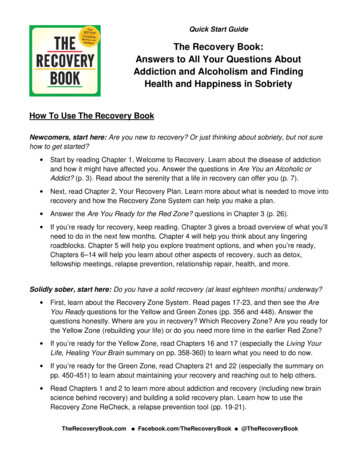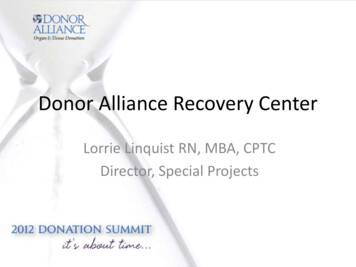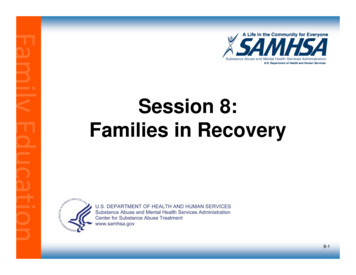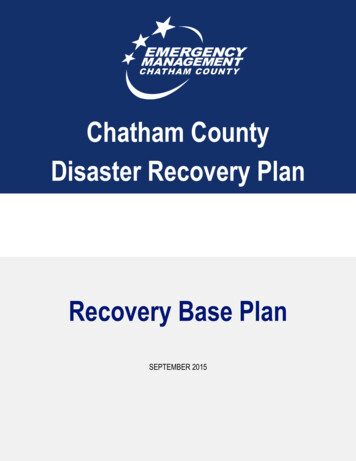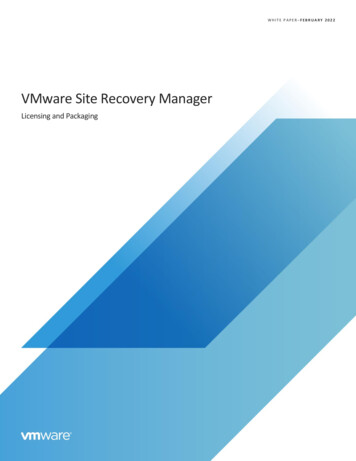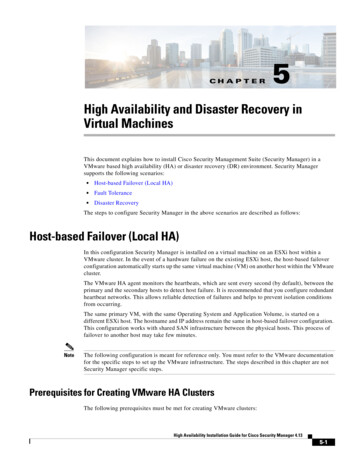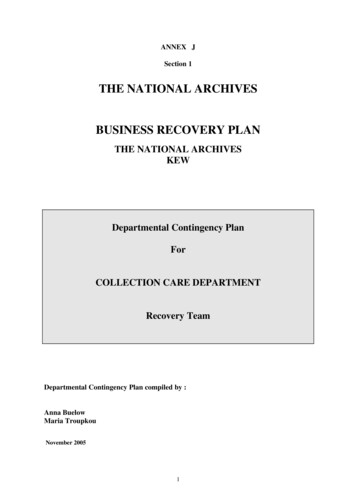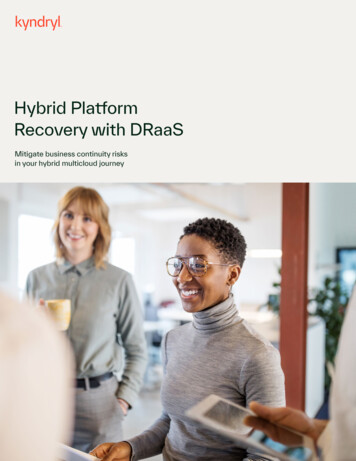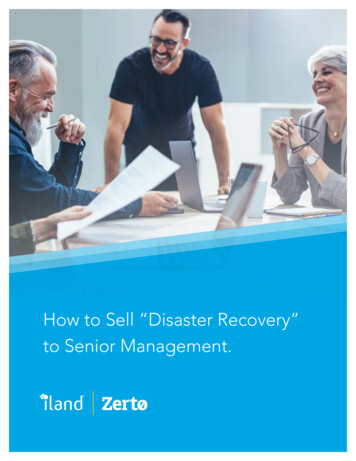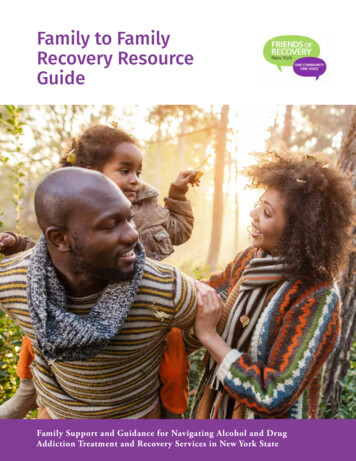
Transcription
Family to FamilyRecovery ResourceGuideFamily Support and Guidance for Navigating Alcohol and DrugAddiction Treatment and Recovery Services in New York State
2FRIENDS OF RECOVERY - NEW YORK: FAMILY TO FAMILY RECOVERY RESOURCE GUIDETable of ContentsAbout this Guide4Background. . . . . . . . . . . . . . . . . . . . . . . . . . . . .Historical Context. . . . . . . . . . . . . . . . . . . . . . . .Purpose of the Resource Guide. . . . . . . . . . . . . .Who It’s For . . . . . . . . . . . . . . . . . . . . . . . . . . . .What to Expect. . . . . . . . . . . . . . . . . . . . . . . . . .Special Terms – Alphabet Soup. . . . . . . . . . . . . .Introduction: What does addictionin a loved-one look like?4555667The Disease of Addiction: Signsand Symptoms . . . . . . . . . . . . . . . . . . . . . . . . . . 8Identification of Specific Substances . . . . . . . . . 10Self-Screening Tools . . . . . . . . . . . . . . . . . . . . . 11Effects of Addiction on the Family . . . . . . . . . . 11How to Start to Talk about Addiction. . . . . . . . 12How to Get Your Loved One to AcceptHelp. . . . . . . . . . . . . . . . . . . . . . . . . . . . . . . . . 13Interventions. . . . . . . . . . . . . . . . . . . . . . . . . . . 14What is Life Threatening? When MedicalSupport is Needed. . . . . . . . . . . . . . . . . . . . . . . 15Drug Tests. . . . . . . . . . . . . . . . . . . . . . . . . . . . . 16Insights from Family members:How We Knew; What it Looked Like. . . . . . . . 18Chapter Resource Box. . . . . . . . . . . . . . . . . . . . 19Care for the FamilyUnderstanding Addiction . . . . . . . . . . . . . . . . .Understanding Recovery. . . . . . . . . . . . . . . . . .Family Education, Supportand/or Treatment . . . . . . . . . . . . . . . . . . . . . . .Mutual Aid Family Support Groups(formerly known as Self-Help) . . . . . . . . . . . . .Al-Anon, Ala-Teen. . . . . . . . . . . . . . . . . .Adult Children of Alcoholics (ACOA). . .202121Nar-Anon Family Groups . . . . . . . . . . . .Codependents Anonymous (CoDA) . . . .Families Anonymous (FA). . . . . . . . . . . .SMART Recovery FamilySupport Groups. . . . . . . . . . . . . . . . . . . .On-Line/Social Media Support. . . . . . . .Grief Recovery Tools/GRASP Groups. . . . . . . .Coping Strategies . . . . . . . . . . . . . . . . . . . . . . .Recovery Advocacy is Nota Recovery Program. . . . . . . . . . . . . . . . . . . . . .2222222222222323Insights from Family members:Where we Found Support. . . . . . . . . . . . . . . . . 24Chapter Resource Box. . . . . . . . . . . . . . . . . . . . 25Where to Get Help for my Loved OneMultiple Pathways of Recovery. . . . . . . . . . . . .Mutual Aid Support Groups . . . . . . . . . .Adjunct Recovery Programs. . . . . . . . . . .Certified Recovery Peer Advocates/Recovery Coaches. . . . . . . . . . . . . . . . . . . . . . .Peer Engagement Specialists . . . . . . . . . . . . . . .Councils on Addiction in NewYork State (CANYS). . . . . . . . . . . . . . . . . . . . .Different Levels of Treatment . . . . . . . . . . . . . .Medication-Assisted Treatment/Recovery . . . . .Finding Services/Availability. . . . . . . . . . . . . . .Telephone Support/HELP Lines. . . . . . . . . . . .Comprehensive On-Line Resources. . . . . . . . . .What to Do While Your LovedOne is on a Waiting List. . . . . . . . . . . . . . . . . .At-Home Detox/When to SeekProfessional Help . . . . . . . . . . . . . . . . . . . . . . .262728282929292933343435363722Insights from Family members:What Helped . . . . . . . . . . . . . . . . . . . . . . . . . . 38222222Chapter Resource Box. . . . . . . . . . . . . . . . . . . . 39
How Do I Support My Loved One?General tips on helping vs. enabling. . . . . . . . . .Family Support Programs and Resources. . . . . .Family Support Navigators. . . . . . . . . . .Recovery Community Organizations. . .Recovery Community OutreachCenters/Youth Club Houses. . . . . . . . . .Co-Occurring Disorders. . . . . . . . . . . . . . . . . .Reoccurrence Warning Signs. . . . . . . . . . . . . . .FOR-NY Trainings:. . . . . . . . . . . . . . . . . . . . . .The Science of Addictionand Recovery. . . . . . . . . . . . . . . . . . . . . .Our Stories Have Power Community Messaging Training . . . . . . .Certified Recovery Peer Advocates(Recovery Coach Academy). . . . . . . . . . .Additional Training: . . . . . . . . . . . . . . . . . . . . .Narcan Naloxone - Opioid Reversal. . . . .Suicide Prevention. . . . . . . . . . . . . . . . . .Trauma and Addiction. . . . . . . . . . . . . . .Legal Issues/Support. . . . . . . . . . . . . . . . . . . . .41Insights from Family members:Navigating the System. . . . . . . . . . . . . . . . . . . . 6342434343Chapter Resource Box. . . . . . . . . . . . . . . . . . . . 64444546484848484848484848Insights from Family members:About Enabling. . . . . . . . . . . . . . . . . . . . . . . . . 49Chapter Resource Box. . . . . . . . . . . . . . . . . . . . 50Overcoming BarriersHow Recovery Peer Advocates/RecoveryCoaches Can Help Remove Barriers . . . . . . . . .Paying for Treatment. . . . . . . . . . . . . . . . . . . . .Insurance Issues. . . . . . . . . . . . . . . . . . . . . . . . .Understanding your Rights - The AppealsProcess. . . . . . . . . . . . . . . . . . . . . . . . . . . . . . . .Patient Safety. . . . . . . . . . . . . . . . . . . . . . . . . . .Confidentiality – Why does it haveto be this way?. . . . . . . . . . . . . . . . . . . . . . . . . .Communicating with your HealthCare Provider . . . . . . . . . . . . . . . . . . . . . . . . . .How to Cope with Stigmaand Discrimination. . . . . . . . . . . . . . . . . . . . . .3TABLE OF CONTENTSFRIENDS OF RECOVERY - NEW YORK: FAMILY TO FAMILY RECOVERY RESOURCE GUIDE5152525355585960Hope DealersAbout FOR-NY . . . . . . . . . . . . . . . . . . . . . . . . 66Family Insights about Recovery. . . . . . . . . . . . . 67Chapter Resource Box. . . . . . . . . . . . . . . . . . . . 68AppendicesTerms to Know. . . . . . . . . . . . . . . . . . . . . . . . .Tools – References and Resources . . . . . . . . . . .Comprehensive Guides. . . . . . . . . . . . . .E- Books. . . . . . . . . . . . . . . . . . . . . . . . .Videos. . . . . . . . . . . . . . . . . . . . . . . . . . .Books . . . . . . . . . . . . . . . . . . . . . . . . . . .Council on Addictions of New York State(CANYS) Directory . . . . . . . . . . . . . . . . . . . . .Family Recovery Resources. . . . . . . . . . . . . . . .Recovery Resources for your Loved One. . . . . .Endnotes. . . . . . . . . . . . . . . . . . . . . . . . . . . . . .Acknowledgments. . . . . . . . . . . . . . . . . . . . . . .Contact FOR-NY. . . . . . . . . . . . . . . . . . . . . . .How To Navigate ThroughThis Guide:Web links (urls) for all videos can befound in the Chapter Resource Boxlocated at the end of each chapter.Web links (urls) for resources citedthroughout this guide can be found inthe appendicesAll information contained in this guide is current as of July 1, 2017.626569707070818282838384858687
1FRIENDS OF RECOVERY - NEW YORK: FAMILY TO FAMILY RECOVERY RESOURCE GUIDEAbout thisRecoveryResourceGuideBACKGROUNDThe FOR-NY Family to Family RecoveryResource Guide was created inresponse to requests for help fromfamilies across New York Statestruggling with addiction. It hasbeen designed to assist and supportfamilies as they navigate their wayfrom active addiction to Recovery.4
FRIENDS OF RECOVERY - NEW YORK: FAMILY TO FAMILY RECOVERY RESOURCE GUIDERecovery implies a journey towards optimalhealth, during which families are empowered torecognize the possibility of change and build on theirstrengths in order to achieve and sustain long termrecovery for themselves and their loved one(s).HISTORICAL CONTEXTThe connection between Dr. Bob Smith and BillWilson (co-founders of Alcoholics Anonymous)changed their lives (and the lives of countless others)by helping them find another alcoholic who could helpbuild and sustain their own recovery from a diseasewhich was stigmatizing, isolating and deadly. Theirconnection and subsequent commitment to connectingwith others, helped millions of people recover from“a seemingly helpless and hopeless state of mind andbody.” (Alcoholics Anonymous, 1939 Forward to theFirst Edition)ABOUT5Bill Wilson’s wife Lois Wilson found herself in needof support to find a way through her own and herhusband’s recovery process as well. With the help ofanother alcoholic’s spouse (Betty B.) she founded thefirst Al-Anon Family Group in 1951. (This was the firstfamily support mutual aid group.) Lois understoodthat the best way to support her husband’s recoverywould be to learn about the illness, take care of herself,and assist other spouses and family members to recoverfrom this family disease.The FOR-NY Family to Family Recovery ResourceGuide was created in that spirit and is based onfeedback from family members across NY State. Withsupport from the Office of Alcoholism and SubstanceAbuse Services (NYS OASAS), FOR-NY hosted severalFamily and Youth Forums to listen and learn aboutwhat is needed to navigate both the system and thiscunning, baffling and powerful disease. It is framed asone family helping another, in a user-friendly format.PURPOSE OF THE RESOURCE GUIDEThis guide is designed to answer three questions:What does alcohol and drug addiction in a loved-one look like?Where can we find support/help for ourselves?Where/How can we get help for our loved ones?WHO IT’S FORThis guide is written for THE FAMILIES of people who have not yet foundrecovery, families of people in recovery, and families who have lost someonedue to addiction. It is for newcomers and old-timers alike. It can be used byindividuals, families, friends and allies of those impacted by addiction, aswell as prevention, treatment, and recovery service providers.
FRIENDS OF RECOVERY - NEW YORK: FAMILY TO FAMILY RECOVERY RESOURCE GUIDEABOUTWHAT TO EXPECTHere’s a snapshot at what you’ll find in the Family to Family RecoveryResource Guide:Resources for the familyIdeas on how to engage your loved oneHow to talk to people about addictionChallenges and potential solutions to navigating the systemBenefits of working together with members of the Recovery communityand other groups. (Dealing with Isolation and Stigma)Real life stories that help to connect us and demonstrate effectivestrategies and tacticsSPECIAL TERMS – ALPHABET SOUPThose of us in the addiction recovery movement often speak with jargon andacronyms that seem like a special code to anyone new to the community. Inan effort to make this resource user-friendly for all, we have included a linkto the Recovery Research Institute’s Addiction-ary in the appendix.6
1FRIENDS OF RECOVERY - NEW YORK: FAMILY TO FAMILY RECOVERY RESOURCE GUIDEIntroductionHow do I know if my loved one hasa problem with drugs or alcohol?If you are reading this, you likelyknow that something is wrong.7
FRIENDS OF RECOVERY - NEW YORK: FAMILY TO FAMILY RECOVERY RESOURCE GUIDEYou may have a feeling in the pit of your stomachor you’ve noticed a change in the way your loved onebehaves or how the entire family interacts differentlythan they had in the past. Something feels off, but youmay not be able to identify it.How do you distinguish this from “normal” behavior?You’ve asked yourself is this “normal adolescentbehavior,” “a midlife crisis” or just stress from work,school, life, etc?You may know that your loved one is using alcohol orother drugs, but is it addiction?THE DISEASE OF ADDICTIONThe disease of addiction is characterized by a compulsionto continue to use alcohol or other drugs despitenegative consequences. These may include an inabilityto control how much they use, social impairment,use in risky situations, and physical/pharmacologicalcriteria (tolerance and withdrawal).Let’s take a closer look and examine some of the generalsigns of alcohol and/or drug addiction.Behavioral Warning Signs and Symptoms: Change in personality or mood (irritability,nervousness, giddiness) Drop in grades or work performance Change in friends/hangouts Isolation Denial, lying and/or stealing Lack of attention to personal hygiene or radicalchange of appearance Wearing long-sleeves or hiding armsAny one of these symptoms alone may not indicateaddiction, however if you are noticing an on-goingpattern it may be cause for concern, especially ifaccompanied by physical changes.INTRODUCTIONPhysical Warning Signs and Symptoms: Unusual sleepiness or hyperactivity Unusually small or large pupils (small or pinnedindicates opiate use) Change in respiratory rate Change in eating habits (increase/loss of appetiteweight loss/gain) Intense flu-like symptoms (nausea, vomiting,sweating, shaky limbs) are indicative of opiatewithdrawal The smell of alcohol or marijuana on their breathEnvironmental Warning Signs and Symptoms: Unusually unkempt bedroom/home Empty bottles or cans Missing medications, shoe laces or belts Burnt or missing spoons and/or bottle caps Syringes, pipes, glass tubes, tin foil, cottonswaps or balls Small bags with powder, crystal or dried plantresidue The smell of alcohol or marijuana (skunk,incense) in their room/home iThe National Council on Alcoholism and DrugDependence, Inc. (NCADD) provides more specificphysical, behavioral and psychological symptoms. Forlink see chapter resource box.SUD DIAGNOSISProfessional testing and evaluation may lead tothe diagnosis of a Substance Use Disorder (SUD).Substance use disorders occur when the recurrentuse of alcohol and/or drugs causes significantimpairment (health problems or failure to meet majorresponsibilities at work, school, or home).For additional facts on common Substance UseDisorders see chapter resource box.If you believe there is an alcohol or drug problem, youmay ask yourself “how bad is it”?8
FRIENDS OF RECOVERY - NEW YORK: FAMILY TO FAMILY RECOVERY RESOURCE GUIDEINTRODUCTIONThe severity of the problem can be assessed using the letters C R A F F T.ii Does your loved one use drugs/alcohol while operating a Car, to Relax or Alone? Do they Forget what they have said or done while using? Are their Friends/Family concerned about their usage? Are they getting into Trouble because of it?While these questions are taken from an adolescent screening tool, they can be applied to a person of any age. If youanswered yes to any of these, further professional assessment may be needed.A Mother talking about thewarning signs she noticed.Video“It’s a club no parent should ever belong to”– Linda V.9
10INTRODUCTIONFRIENDS OF RECOVERY - NEW YORK: FAMILY TO FAMILY RECOVERY RESOURCE GUIDEIDENTIFICATION OF SPECIFIC SUBSTANCES iii :During our family forums, family members told us that they needed information on how to identify substances.Different substances produce different physical and emotional indicators of use.They can be identified by how they look and what they are called “on the street.”CR ACKCOC AINEHEROININHAL ANTSM ARIJUANABoozeBlow,Coke,Rock,SnowBlack tar,Dope, unt, dope,grass, herb,Maryjane,pot reefer,skunk, weedIce, chalk,Benzos, tranx sleeperscrank,& in-clude: Xanax,crystal, fire, Valium and KlonipinMeth, r,chips,chunksor whiterocksWhite todark brownpowder ortar-like substance, canalso looklike a chipGreen/greymix of driedflowers/leaves ofhemp plantWhite orslightlyyellowcrystal likepowder,large rocklike chunksHow it’s ree based orsnortedPaint thinners, gules,nail polishremover,whippedcreamaerosol, airconditionerfluid andmoreInhaledSmoked,brewed intotea or imbedin foods.Swallowed,injected,snorted orsmokedSigns of Slurredabusespeech,lack lowed andslurredspeech,vomitingSlowedthinking& reaction timeimpaired coordinationparanoiaNervousphysicalactivity,scabs andopen sores,decreasedappetite,inability holdproducts,a drunk,dazed ordizzy appearanceMETHA MPHETA MINEBENZODIA ZEPINESOPIATES/PAINMEDIC ercocet,Perka,Vicodin,Vitamin V,VikaTablets, capsules often Tablets,capsules,stolen from familymembers or obtained transdermalthrough prescriptions patches andfor anxietytable salt.Swallowed, crushedand injected orsnortedSwallowed,crushed andinjected, orlicked offthe ed vision,Missing Rx,Poor coordinationdisruptedAmnesia, Hostility,eating andIrritability, Disturbing sleeping,dreams, Reduceddark circlesinhibition,Impairedunder eyes,judgmentnodding out
FRIENDS OF RECOVERY - NEW YORK: FAMILY TO FAMILY RECOVERY RESOURCE GUIDEINTRODUCTIONALCOHOL AND DRUG USE SCREENING TOOLSCounselors use a variety of screening tools. Although not a substitute for professional diagnosis, we have included a fewhere for your information:1. A self-administered version of one is the CRAFFT screening tool referenced earlier in this section, for use byadolescents. English and Spanish versions can be found in the Appendix.2. The National Council on Alcoholism and Drug Dependence (NCADD) provides self-tests for adults andadolescents. See chapter resource box for link.3. For an alcohol specific tool see chapter resource box for link.EFFECTS OF ADDICTION ON THE FAMILYIllness Effects theOne Addicted1 Illness Effects theSurrounding ival RolesDevelop to Copea few include:The Enabler (or the hero)who takes on the responsibilities ofthe addicted personThe Mascot who distractsevery one with humorThe Lost who “checks out”or remains aloofThe Scapegoat who actsout the dysfunctionAddiction is often referred to as a disease of 1 4, meaning that the illness effects not only the one addicted, but at leastfour more. It is a family disease and as such, can have a devastating effect on every member of the family.Families can become dysfunctional as the illness progresses. Due to the shame and stigma that so often surroundalcohol and drug addiction, it is typically kept secret. Faced with a loved one’s addiction, family members frequentlytake on specific survival roles to cope with the chaos addiction brings. For example, one might become the enabler(or the hero) who takes on the responsibilities of the addicted person, the mascot who distracts every one with humor,the lost who “checks out” or remains aloof, the scapegoat who acts out the dysfunction, etc. When families get healthier,those survival roles can develop into strong coping skills.As the addicted person needs to learn ways to cope with his or her disease, so do the members of their family.Community support can be incredibly effective in helping families affected by addiction. As one family member hassaid: “If it were any other illness, friends and neighbors would be stopping over with dishes of lasagna.” That’s not thecase with addiction. Most family members suffer in silence and isolation. Finding other families who are affected iscrucial. Help is available! Here’s where to begin.11
FRIENDS OF RECOVERY - NEW YORK: FAMILY TO FAMILY RECOVERY RESOURCE GUIDEINTRODUCTIONHOW TO START TO TALK ABOUT ADDICTION WITH YOUR LOVED ONEHAVING THE CONVERSATIONIf you have gotten this far in the guide you may be asking, “So now that we know there is a problem, how do we beginto address it?”The NYS Office of Alcoholism and Substance Abuse Services (OASAS) has produced a series of informational videosthat you can view by yourself, with a community group or with your loved one to get the conversation started.Talking with the CommunityVideoTalking with Young PeopleVideoSYNOPSIS OF THE VIDEOSThese videos are intended to spark a discussion about alcohol and drug addiction. The main messages contained thereinare: “Addiction can happen in any family.” “Recovery is real.” “There is hope.”Use them to begin a conversation with a person or a group of people after viewing one or both of them together. Theycontain first hand stories about the impact of substance use disorders on individuals and families.Denial is prevalent: most parents say “Not my child. This can’t happen to him.”Fact: It can happen to anyone! The high school cheerleader and the varsity athlete can end up committing criminal actsto support their habits.“9 out of 10 people with addiction started using substances beforethey turned 18”“Just smoking pot or drinking in adolescence can lead to addiction,despite what parents believe. A recent study found that only 12% ofparents see drugs & alcohol as a problem for their children.”“Nearly half of young people who inject heroin report abusingprescription pain killers before starting to use heroin.”The videos talk about the Behavioral Signs of Drug Use and the Advanced Warning Signs of Heroin use, includingPhysical Signs. Denial, a common symptom of addiction, will often result in family members noticing a problembefore the addicted person does. This is an opportunity to intervene. Addiction does not discriminate. It can happen toanyone even with the best parenting. Addiction is a chronic, progressive, and if left untreated, fatal disease that can begenetically predisposed.12
FRIENDS OF RECOVERY - NEW YORK: FAMILY TO FAMILY RECOVERY RESOURCE GUIDEINTRODUCTIONSOME OPTIONS FOR FAMILY MEMBERS:Talk to an experienced professional who specializes in addiction.Talk to your family about the dangers of substance use in yourhome, during meals, in the car, at the game. Always keep the lines ofcommunication open.Listen to what people are saying; respect goes a long way.Explain that addiction is progressive and chronic.Discuss expectations surrounding alcohol & drug use.Be a positive role model.Work with a Certified Recovery Peer Advocate who specializes in familyrecovery (CRPA-F), a Family Recovery Coach, Family Support Navigator,Family Therapist or other Peer Specialist to develop healthy boundaries,effective communication and wellness strategies for the family.HOW TO GET MY LOVED ONE TO ACCEPT HELPGetting your loved one to accept that they have problem and need help isnot easy, but there are steps that you can take to make it a little easier.Educate yourself on addictionEducate yourself on the family disease componentFind support for you and your familyIdentify several optionsInvite your loved one into a conversation about optionsavailable for them13
FRIENDS OF RECOVERY - NEW YORK: FAMILY TO FAMILY RECOVERY RESOURCE GUIDEINTRODUCTIONINTERVENTIONAn intervention is an organized effort, by family and friends, with professional assistance – to get someone to seekprofessional help for an addiction. They can be direct or indirect, typically involving a “confrontational” meeting withthe individual or working with a family member to teach them how to be helpful to the addicted person.There are three major models of intervention in use today 1) the Johnson Model, 2) the Arise Intervention Model and3) the Systemic Family Model.ivWhile some interventionists may prefer one model over the others, many are able to blend models based on whatwould be most effective for the addicted person and their family.For Intervention tips and guidelines see chapter resource box for link.There are a number of individuals claiming to be “interventionists” who have no training in a formal model.Some are hired by disreputable treatment programs merely to recruit patients. Please conduct some research andverify credentials before you hire someone.Visit g/ for more suggestions.One model that has been successful is:COMMUNITY REINFORCEMENT AND FAMILY TRAINING (CRAFT) vCRAFT teaches family and friends effective strategies for initiating theirloved ones into recovery and for healing themselves. CRAFT works to affectthe loved one’s behavior by changing the way the family interacts with himor her. It is designed to accomplish three goals:When a loved one is misusing substances and refusing to get help,CRAFT helps families invite their loved one into treatment optionsOn its own, CRAFT helps reduce the loved one’s alcohol and drug use,even if the loved one has not yet engaged in treatment.CRAFT improves the lives of the concerned family and friends.iiiFor more information on CRAFT see chapter resource box for link.14
FRIENDS OF RECOVERY - NEW YORK: FAMILY TO FAMILY RECOVERY RESOURCE GUIDEINTRODUCTIONDRUG TESTSWhile at home drug testing kits are available at your local pharmacy, there may be some question whether or not thefamily should test. Some families test and test often, but the evidence is inconclusive on whether or not this is helpful.According to 7 Reasons Parents Should Not Test Kids for Drug Use (U.S. News and World Report, Aug. 6, 2008), thereare multiple reasons why parents should not test kids for drug use. Most notably, it can be a missed opportunity forcommunication, tests are not always accurate, they are not cheat-proof, and they can be costly.viOn the other hand, there is evidence that the use of urine testing can be helpful (particularly after treatment), insupporting your loved one’s recovery; and could be used as a condition for remaining at home, especially if done incoordination with their treatment team.If your loved one is in outpatient treatment and you are concerned they may use alcohol or drugs, providers conductregular drug testing in conjunction with counseling. You may want to ask your loved one to sign a release ofinformation allowing you to have access to this information.“Testing can become a condition for remaining at home for a youngadult in early recovery – as part of a recovery contract, for example.If a parent suspects their child is heading for or has experienced arelapse, they could agree to a supervised drug test.”– Lori Dresher (Parent, Family Recovery Coach)15
FRIENDS OF RECOVERY - NEW YORK: FAMILY TO FAMILY RECOVERY RESOURCE GUIDEINTRODUCTIONWHAT IS LIFE THREATENING? WHEN MEDICAL SUPPORT IS NEEDEDAddiction is a chronic, sometimes fatal, illness that may require multiple andcontinuous intervention over an extended period of time. However, there aretimes when immediate medical support is needed and a person should betaken to a medical facility. An Unconscious or Unresponsive Person may neverwake up, call 911 immediately and get them to a hospital.The 911 Good Samaritan Law allows people to call 911 without fear of arrest(for possession of a minor personal amount of illicit drugs or paraphernalia)if they are witness to a drug overdose that requires emergency medical care.OPIATE OVERDOSE: Symptoms include unresponsiveness, not breathingor breathing very slowly, making gurgling sounds, blue or grayish lips orskin. Administer Naloxone (Narcan), an overdose reversal drug and call911. Provide CPR and rescue breathing if necessary. For a list of agenciesthat participate in training on how to administer this life savingmedication, see the Community Calendar of Opioid Overdose Trainings.ALCOHOL OVERDOSE (Alcohol poisoning): Symptoms include confusion;difficulty remaining conscious; vomiting; seizures; trouble with breathing;slow heart rate; clammy skin; dulled responses, such as no gag reflex(which prevents choking); and extremely low body temperature. Alcoholoverdose can be fatal. Medical attention is required immediately.MIXING ALCOHOL WITH OTHER DRUGS is very dangerous, and amplifiesthe effect of both (synergy) and can also be life threatening. Medicalattention is needed immediately.ALCOHOL WITHDRAWAL can cause seizures and can be life-threatening.Detoxification from Alcohol should be done with medical supervision.Medical attention is needed immediately.OPIATE WITHDRAWAL can be extremely painful and although not lifethreatening in and of itself, often requires medication to ease thesesymptoms. This will significantly aid your loved in following through with arecovery program. (Opiates include OxyContin, Oxycodone, Hydrocodone,Fentanyl, Percocet, Vicodin, Morphine, Demerol and Heroin). Severedehydration can be life threatening. Consult with a physician or medicalprofessional if you suspect your loved one is in withdrawal.For more information on 911 Good Samaritan Law see chapter resource box for link.For Opiate Overdose Training Calendar see chapter resource box for link.16
FRIENDS OF RECOVERY - NEW YORK: FAMILY TO FAMILY RECOVERY RESOURCE GUIDEINTRODUCTIONDrinking or using drugs while driving is illegal and dangerous behavior. For the benefit of public safety, this mayrequire you to contact lo
The FOR-NY Family to Family Recovery Resource Guide was created in response to requests for help from families across New York State struggling with addiction. It has been designed to assist and support families as they navigate their way from active addiction to Recovery. About this Recovery Resource Guide 1

